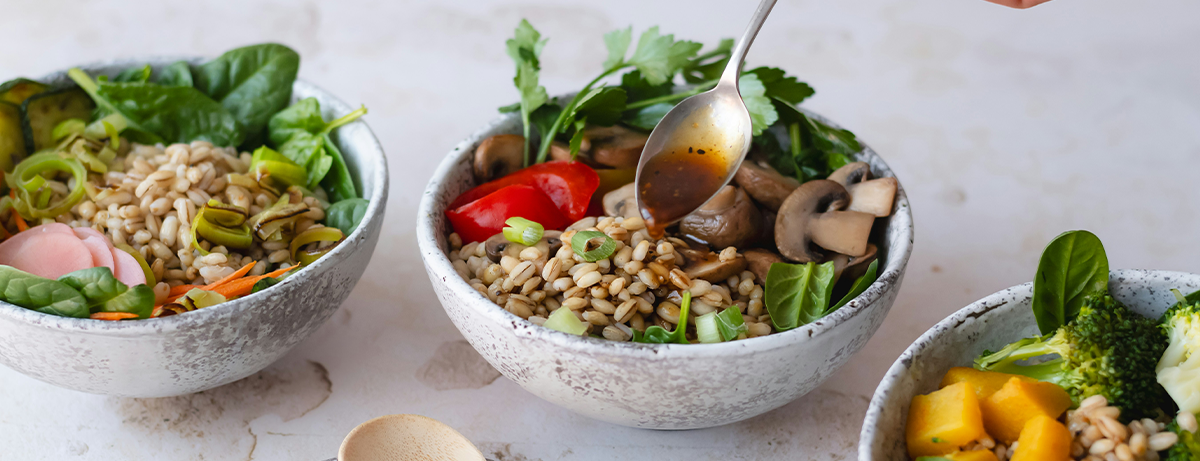15% off £25 or 20% off £35
Code:BASKET
IBS diet: low FODMAP explained by a dietitian

With a name only a scientist could love, the low FODMAP diet has moved from clinics into everyday life. But how does it actually work? And could it help people with gut sensitivities like IBS?
Summary
1What’s the low FODMAP diet?
A low FODMAP diet limits certain carbs that aren’t easily absorbed by the gut, helping people spot which foods trigger discomfort…
2Does the low FODMAP diet work?
Studies suggest it can ease digestive issues for some when done properly, though it’s not a long-term lifestyle diet…
3How to start a low FODMAP diet
Work with a FODMAP-trained dietitian. Begin by swapping out high FODMAP foods for lower alternatives, then reintroduce gradually…
You might have heard the term “low FODMAP diet” pop up in conversations about gut health – but what exactly does it mean, why do people follow it and does it really link to IBS? To help us unpack the science, we spoke with Hazel Clarke, BDA-registered consultant dietitian, about what’s really behind this eating plan.
What’s the low FODMAP diet?
A low FODMAP diet means cutting out certain types of foods called FODMAPs – fermentable oligosaccharides, disaccharides, monosaccharides and polyols – quite a mouthful, right?¹⁻⁴ If you’ve never heard of these before, don’t worry, here’s a simple breakdown of what they are and where you’ll find them:
- oligosaccharides: includes fructans and galacto-oligosaccharides, found in foods like wheat, rye, pulses and some vegetables
- disaccharides: mainly lactose, the sugar in dairy products
- monosaccharides: refers to fructose, present in fruit and added sugar
- polyols: mannitol, sorbitol and xylitol, which appear in some fruits, vegetables and artificial sweeteners
Why these carbs can be a problem for some
So why all the fuss? These carbohydrates are poorly absorbed in the gut, which means they hang around in the intestines longer than usual. As Hazel explains: “This is completely normal, and has a positive effect for those without sensitivities. But for some people, it can cause digestive symptoms.” When FODMAPs linger, they draw in water, while gut bacteria get to work fermenting them – a process that produces gas and more fluid.⁴ For some, this can trigger bloating, pain, or changes in bowel habits.
Does the low FODMAP diet work for IBS?
Research suggests that a low FODMAP diet may ease digestive discomfort in certain people. A meta-analysis found that around 70% of people with irritable bowel syndrome (IBS) noticed improvements in their gastrointestinal symptoms after following it.⁵ Other studies have also shown improvements in quality of life for participants.²
Hazel says: “FODMAP-trained dietitians are the only people professionally recommended to support people with this diet. You’re more likely to complete it effectively and see benefits if you have dietetic support – 60% more likely, versus 40% without support.” That said, it isn’t a lifestyle diet to adopt long term. Because FODMAP foods include many fruits, vegetables, grains and dairy products, the diet can restrict important nutrients if followed without guidance.³,⁶
The drawbacks of a low FODMAP diet
While the diet may be useful for identifying trigger foods, it also has some potential drawbacks:
- nutrient deficiencies – cutting out so many foods can reduce intake of vitamins B, C and D, as well as minerals like calcium, iron and zinc⁶,⁷
- impact on gut microbes – research shows the diet can change the balance of bacteria in the gut, though we don’t fully understand the long-term effects³,⁶⁻⁹
- tricky to follow – with many everyday foods high in FODMAPs, it can be a challenge to stick to
Hazel explains: “We tend to recommend putting basic healthy eating habits in place first – like eating regular meals, staying hydrated and adjusting fibre intake gradually – before starting the low FODMAP diet. Otherwise, it could be ineffective because you’re missing simple, but helpful, changes.”
How to start a low FODMAP diet
If you do choose to explore a low FODMAP diet, always do so with guidance from a FODMAP-trained dietitian.³ The process usually follows three stages:

- restriction (around 6 weeks): swap out high-FODMAP foods for low FODMAP alternatives⁴,⁹
- reintroduction: gradually reintroduce FODMAP foods one at a time and track your reactions⁹,¹¹
- personalisation: work with your dietitian to create the least restrictive diet that avoids your individual triggers⁹,¹¹
Low FODMAP foods you can enjoy
It’s not all about restrictions – there are still plenty of foods you can enjoy on a low FODMAP diet. Some examples include:
- vegetables: aubergine, courgette, carrot, parsnip, spinach, rocket, cucumber
- fruit: bananas, blueberries, strawberries, grapes, kiwi, citrus fruits
- proteins: beef, chicken, lamb, pork, fish, eggs, firm tofu, tempeh
- grains: oats, rice, corn, quinoa (opt for gluten-free versions of bread or pasta made from these)
Lactose-free and plant-based dairy alternatives are usually suitable, while onion, garlic, wheat, rye and barley are among the foods best avoided.¹²
Keeping a food diary
One of the most helpful tools when trialling a low FODMAP diet is a food diary.³ By recording what you eat, when you eat it, and any symptoms you notice, you can identify patterns and discuss them with your dietitian.
The final say
The low FODMAP diet can be an empowering way to discover more about how your body responds to different foods. By following the process step by step – and with the support of a FODMAP-trained dietitian – many people gain clarity on what works best for them. It’s designed as a short-term tool, not a lifelong plan, but the insights you gain can help you build a diet that feels balanced and personal to you.
As Hazel sums it up: “It’s all about finding the least restrictive diet you can, while still avoiding the foods that don’t agree with you.”
Disclaimer - The advice in this article is for information only and should not replace medical care. Please check with your GP, dietitian or healthcare professional before trying any supplements, treatments or remedies. Food supplements must not be used as a substitute for a varied and balanced diet and a healthy lifestyle.
While we strive for accuracy and balance, please be aware that this article may discuss products available for purchase through Holland & Barrett. Consult a healthcare professional before making any health-related decisions.
1. Nanayakkara WS, et al. Efficacy of the low FODMAP diet for treating irritable bowel syndrome: The evidence to date. Clin Exp Gastroenterol. 2016;9:131–42. https://doi.org/10.2147/CEG.S86798
2. van Lanen A-S, et al. Efficacy of a low-FODMAP diet in adult irritable bowel syndrome: a systematic review and meta-analysis. Eur J Nutr. 2021;60(6):3505–22. https://doi.org/10.1007/s00394-020-02473-0
3. NICE. Irritable bowel syndrome: Management [Internet]. [cited 2025 Feb 19]. Available from: https://cks.nice.org.uk/topics/irritable-bowel-syndrome/management/management/
4. Barrett JS. How to institute the low-FODMAP diet. J Gastroenterol Hepatol. 2017;32(S1):8–10. https://doi.org/10.1111/jgh.13686
5. Altobelli, E, et al. Low-FODMAP Diet Improves Irritable Bowel Syndrome Symptoms: A Meta-Analysis. Nutrients. 2017;9 9):940. https://doi.org/10.3390/nu9090940
6. Hill et al. Controversies and recent developments of the low-FODMAP diet. Gastroenterol Hepatol (N Y). 2017;13(1):36–45. https://pubmed.ncbi.nlm.nih.gov/28420945/
7. Catassi G, et al. The low FODMAP diet: Many question marks for a catchy acronym. Nutrients. 2017;9(3):292. https://doi.org/10.3390/nu9030292
8. Chumpitazi BP, et al. Randomised clinical trial: Gut microbiome biomarkers are associated with clinical response to a low FODMAP diet in children with the irritable bowel syndrome. Aliment Pharmacol Ther. 2015;42(4):418–27. https://doi.org/10.1111/apt.13286
9. Monash University. Starting the low FODMAP diet - Monash FODMAP [Internet]. [cited 2025 Feb 19]. Available from: https://www.monashfodmap.com/ibs-central/i-have-ibs/starting-the-low-fodmap-diet/
10. BDA. Irritable bowel syndrome IBS) and diet factsheet [Internet]. [cited 2025 Apr 4]. Available from: https://www.bda.uk.com/resource/irritable-bowel-syndrome-diet.html
11. Tuck et al. Re-challenging FODMAPs: The low FODMAP diet phase two. J Gastroenterol Hepatol. 2017;32:11–15. https://doi.org/10.1111/jgh.13687
12. NHS. IBS and the low FODMAP diet [Internet]. [cited 2025 Feb 19]. Available from: https://www.gloshospitals.nhs.uk/media/documents/FODMAP_dietsheet_for_website.pdf
13. NHS. Keeping a food diary when you have symptoms of IBS. [Internet]. [cited 2025 Mar 19]. Available from: Keeping a food diary when you have symptoms of irritable bowel syndrome (IBS)












